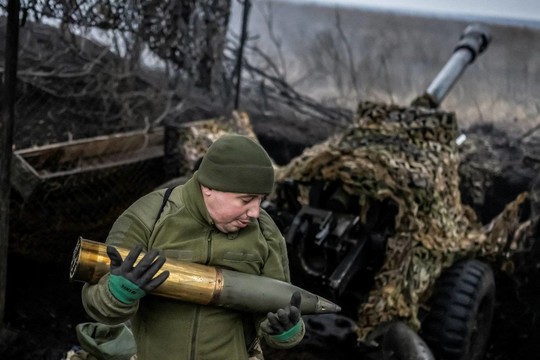A Ukrainian soldier carries a ‘bullet’.
Photo: Reuters
If Congress fails to pass a national security supplemental funding bill, Ukraine will be getting fewer bullets, notes ‘The Foreign Policy’.
In fighting the largest land war in Europe since World War II, Russia has expended between 12 to 17 million rounds of artillery ammunition since its full-scale invasion of Ukraine two years ago; the astronomical rates of fire have been used to dislodge entrenched defenses and spur advances on both sides.
The U.S. defense industrial base has more than doubled its output of 155 mm artillery ammunition since December 2022. U.S. companies are currently producing about 30,000 shells a month, and the Army hopes to increase that tally to 60,000 rounds per month by September 2024, and to 100,000 rounds per month by the end of 2025.
“We’ve got two issues in terms of defense budgets,” said Jeb Nadaner, a former U.S. deputy assistant secretary of defense for industrial policy. “One is the orders you place, in a year’s budget. But the other one is, can the industrial base produce it? And the base is really creaky.”
With no U.S. artillery ammunition arriving in Ukraine since December, Kyiv has tried to build more weapons of its own.
Ukraine has received about 300 artillery weapons capable of firing 155 mm rounds since the start of the war — nearly half of them coming from the United States — ranging from U.S.-made M777 howitzer cannons to French Caesar guns and self-propelled German Panzerhaubitze.
But with rounds supplied by U.S. producers dwindling, European countries are turning to ad hoc solutions to keep Ukrainian guns firing. NATO has signed a $1.2 billion artillery ammunition contract to procure rounds on behalf of Belgium, Lithuania, and Spain. The European Union — which is months late on its target of producing 1 million artillery shells by the start of this month — is hoping to get to 1.4 million shells produced by the end of the year. But short of that, a Czech-led initiative has sought to source 800,000 rounds of artillery ammo from outside the European Union for Ukraine.
And while European officials are confident that they can continue the upward trajectory for artillery ammunition production and other weapons needed to help the Ukrainians, such as air defense projectiles, they insist that they can’t do it without the United States, which has a larger overall defense industrial base.
“We physically don’t have the weapons that are needed at the front,” said Radoslaw Sikorski, Poland’s foreign minister, at a breakfast hosted by the Christian Science Monitor in Washington on Tuesday. If the aid package doesn’t arrive, Sikorski said, NATO’s eastern flank will likely need to be reinforced with more U.S. troops.
Ukraine is down to firing less than 2,000 rounds per day, down from around 6,000 per day last summer. Researchers estimate that Ukraine needs to fire at least 75,000 rounds a month — more than its current rates — to keep up a defensive war. Without enough rounds, U.S. defense officials say, Ukraine could be pushed back.
“Just look at what’s happening on the battlefield today around Avdeevka and other places,” a senior U.S. defense official told reporters on Tuesday, referring to a Ukrainian city that recently fell to Russian forces. “Ukrainians are struggling without ammunition.”
Still, Washington’s artillery shell production goal for the end of next year is less than half of what Russia is producing right now. And Russia’s economy, which has been converted to mobilize for war, is outproducing countries on both sides of the Atlantic Ocean all on its own. CNN reported on Monday that Russia was on track to produce three times more munitions than the United States and Europe combined this year.
And the Biden administration’s massive $850 billion defense budget plan would cut the amount of money that the Pentagon is pledging to build up training grounds and stage U.S. troops on NATO’s eastern flank. Those cuts are due to the U.S. military’s desire to focus on preparations for a future conflict with China, said Maj. Gen. Charles Lombardo, the director of training for the Army’s deputy chief of staff, during a press call.
read more in our Telegram-channel https://t.me/The_International_Affairs

 9:51 24.03.2024 •
9:51 24.03.2024 •























